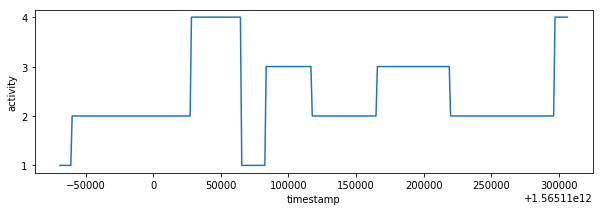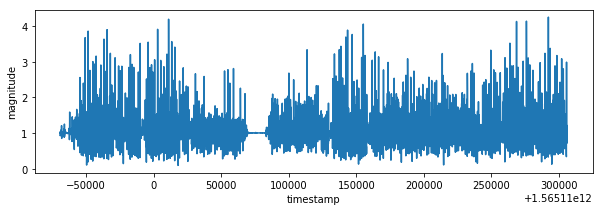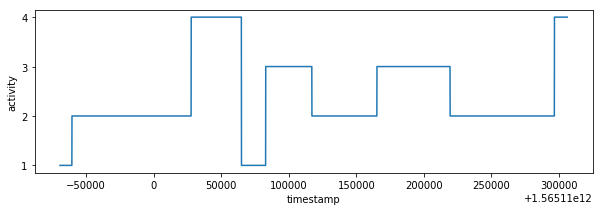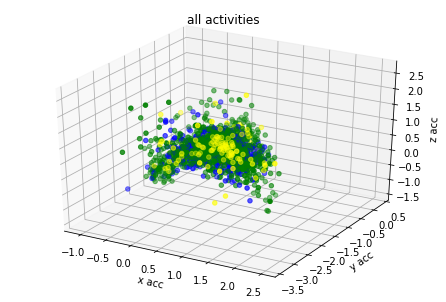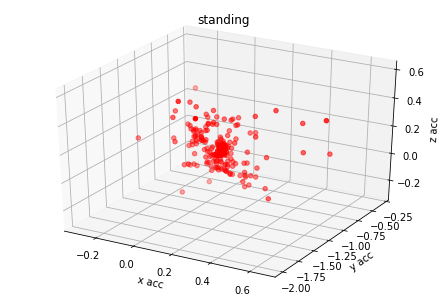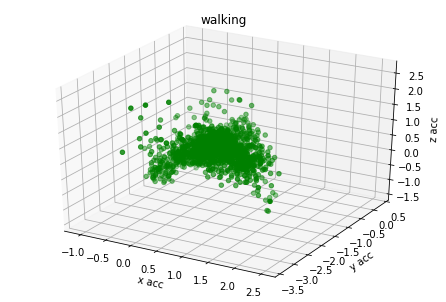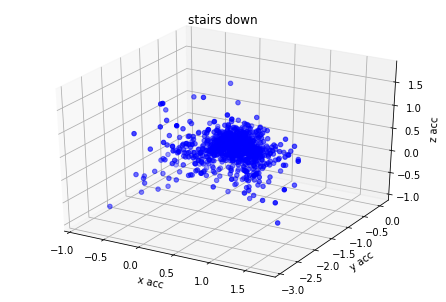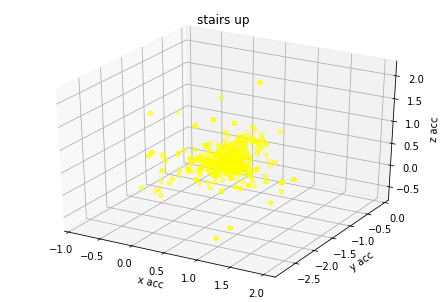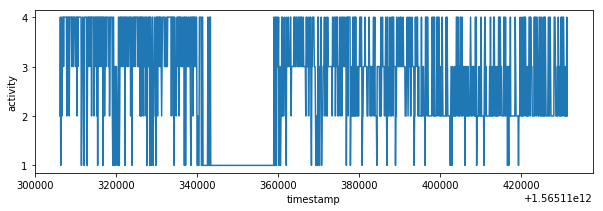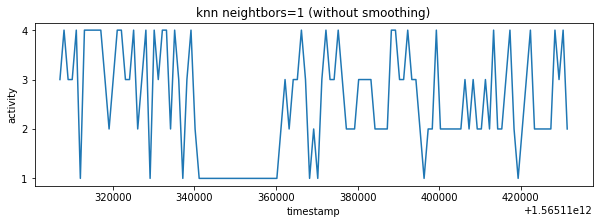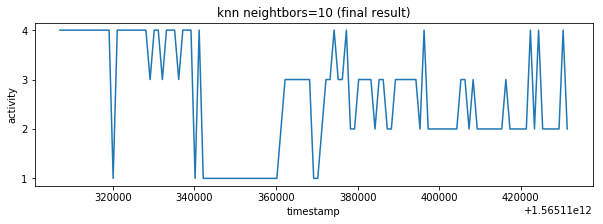Author: Hynek Buček, 3uky
The final project is focused on prediction of the human physical activity (walking, standing, ascending and descending stairs) based on data from tri-axial smartphone accelerometer.
Input data-set contains training and test data in csv format each set consists of two csv files:
-
The first training file train_time_series.csv contains accelerometer data. There are 1250 records sampled every 0.1 second. The file is used as input for classification model training. Every record has following features/columns.
sample number, timestamp, UTC time, accuracy, x, y, z -
The second training file train_labels.csv contains label column with integer values encoding the human physical activity (1=standing, 2=walking, 3=descending, 4=ascending). There are just 125 records and sampling rate is 1 second so there are 10 times less records then in previous training csv file. Every record has following features.
sample number, timestamp, UTC time, label
Test data consists of two csv files test_time_series.csv and test_labels.csv with same structure, sampling rate and number of records as training data-set. The test_time_series.csv is used as input for classification model. Based on predicted labels is necessary determine final labels in test_labels.csv. The test_labels.csv is final result the main goal of this project and completed file has to be submitted.
The goal is to classify different physical activities as accurately as possible. The classification model would be created based on training input data (supervised machine learning) and the model would be used for test data classification. Part of this project is also creation of this Jupyter Lab report and run-time measurement.
- data analysis
- data pre-processing (data cleaning, data balancing, determine labels for test_time_series.csv, additional covariate computation)
- covariate specification (accuracy x, y, z and magnitude)
- models scoring (best score has random forest classifier)
- model training
- input data classification
- result data augmentation (knn smoothing)
I have analyzed csv files structure and values. The train_time_series.csv and train_labes.csv have different sampling times. It's possible to extract labels from train_labels.csv because label values are consistent in time and activity state is changing every several seconds not milliseconds.
The test data from test_time_series.csv would be used as input data for classification. A result would be necessary augmented because of different sampling rate in test_labels.csv. I have decided use knn classifier with 10 neighbors the final label would be selected based on timestamp and majority vote of 10 closest predicted labels.
I have checked GitHub projects related to HAR "Human Activity Recognition" with use of acceleration measurements and found that is possible to calculate acceleration magnitude from x, y, z accuracy and used it as training covariates. The magnitude equation is as follow:
- The training_labels.csv contain labels for every 10 observations in training_time_series.csv. Missing labels could be determined based on closest timestamp.
- Based on data analysis I have used x, y, z accuracy and calculated magnitude as model training covariates.
- I have found that training data are Imbalanced. I have partially solved this issue with over-sampling. I have used confusion matrix for re-sampling result verification.
- I have score several classification models with cross-validation and batch_classify and found that random forest classifier has best result. I have trained model with provided post-processed input data.
- I was experimenting with manual prediction, splitting train data-set on train and validation data and used them for model training and prediction verification.
- I have predicted labels of input data test_time_series.csv based on trained model.
- Predicted data were re-sampled with K-nearest neighbor classifier and stored in test_lables.csv files. The result is presented also as graph and as list of labels.
import pandas as pd
import numpy as np
import matplotlib.pyplot as plt
import warnings
warnings.filterwarnings("ignore")def plot_xy(x, y, y_title="acceleration"):
fig = plt.figure(figsize=(10, 3))
plt.xlabel("timestamp")
plt.ylabel(y_title)
plt.plot(x, y)
plt.show()
def plot_activity(x, y, title=''):
fig = plt.figure(figsize=(10, 3))
plt.xlabel("timestamp")
plt.ylabel("activity")
plt.plot(x, y)
#plt.yticks([1, 2, 3, 4], ["standing", "walking", "stairs down", "stairs up"])
plt.yticks([1, 2, 3, 4])
plt.title(title)
plt.show()
df_labels = pd.read_csv('train_labels.csv', usecols=["timestamp", "label"])
# labels/activities are consistent in time
plot_activity(df_labels.timestamp, df_labels.label)def plot_data(df):
selection = df.iloc[:]
plt.figure(figsize=(10,3))
plt.plot(selection.timestamp, selection.x, linewidth=0.5, color='r', label='x acc')
plt.plot(selection.timestamp, selection.y, linewidth=0.5, color='b', label='y acc')
plt.plot(selection.timestamp, selection.z, linewidth=0.5, color='g', label='z acc')
plt.xlabel('timestamp')
plt.ylabel('acceleration')
plt.legend(loc='center left', bbox_to_anchor=(1, 0.5));
plt.show
# reading training csv data
df_train = pd.read_csv('train_time_series.csv', usecols=["timestamp","x","y","z"])
plot_data(df_train)I have created magnitude from accuracy values. The labels could be determined from train_labels.csv file based on closest timestamp. It's necessary to duplicate relevant labels because of different sampling rate. This data processing is possible due to fact that human activity is changing every several seconds not every several milliseconds, it's visible also on activity graph from train_labels.csv.
def add_magnitude(df):
df['m'] = np.sqrt(df.x**2 + df.y**2 + df.z**2)
# read labels from train_labels.csv and set label value in train_time_series data frame based on nearest timestamp value
def add_label(df_train):
df_train['label'] = df_train['timestamp'].map(lambda timestamp: get_label(df_labels, timestamp))
def get_label(df_labels, timestamp):
timestamps = np.asarray(df_labels.timestamp)
idx = (np.abs(timestamps - timestamp)).argmin()
return df_labels.iloc[idx].label
# calculate new columns
add_magnitude(df_train)
add_label(df_train)
plot_xy(df_train.timestamp, df_train.m, "magnitude")
plot_activity(df_train.timestamp, df_train.label)I have created 3d plots for accelerations and color them by assigned label. There is visible some clustering but acceleration values of different labels are overlaying. I think it's because human activity cannot be predicted based on single axis accuracy but on their combination.
from mpl_toolkits.mplot3d import Axes3D
def plot_xyz(selection, title=''):
colors = {1:'red', 2:'green', 3:'blue', 4:'yellow'}
fig = plt.figure()
ax = fig.add_subplot(projection='3d')
ax = Axes3D(fig)
ax.set_title(title)
ax.set_xlabel('x acc')
ax.set_ylabel('y acc')
ax.set_zlabel('z acc')
ax.scatter(selection.x, selection.y, selection.z, c=selection.label.map(colors));
# 3d plot for all accuracy colored by it's labels
plot_xyz(df_train, "all activities")
# 3d plot for separated accuracy
for label_number,activity in {1:'standing', 2:'walking', 3:'stairs down', 4:'stairs up'}.items():
plot_xyz(df_train[df_train.label == label_number], activity)Based on graph results the acceleration data has relation with labels. I have found from different GitHub projects and scientific articles that magnitude could be used also as additional covariate for model training.
# Specify classification_outcome Y and covariate X
classification_target = 'label'
all_covariates = ['x', 'y', 'z', 'm']
Y = df_train[classification_target]
X = df_train[all_covariates]There is uneven count of labels in training input data-set. Imbalanced classification is the problem of classification when there is an unequal distribution of classes. Imbalanced data could lead to classification bias. For solving of this problem I was experimenting with under/over sampling of training data-set. There is very large data lost with under-sampling and trained model provided unstable results. Over-sampling had better results but confusion matrix revealed that classification for classes 2, 3, 4 isn't precise.
from imblearn.over_sampling import RandomOverSampler
from imblearn.under_sampling import RandomUnderSampler
from siml.signal_analysis_utils import *
print("Imbalanced class distribution before re-sampling:\n{}".format(Y.value_counts()))
ros = RandomOverSampler()
X, Y = ros.fit_resample(X, Y)
print("Class distribution after re-sampling:\n{}".format(Y.value_counts()))Imbalanced class distribution before re-sampling:
2 2130
3 881
4 465
1 268
Name: label, dtype: int64
Class distribution after re-sampling:
1 2130
2 2130
3 2130
4 2130
Name: label, dtype: int64
Confusion matrix could reflect more details on classification accuracy. Each row of the matrix represents the instances in actual class while each column represents the instances in a predicted class. This is very useful for verification of re-sampling from previous step. I have better results with over-sampling than with under-sampling. I was trying also combination with sampling strategy but I didn't get much better results than with pure over-sampling.
from sklearn.metrics import confusion_matrix
from sklearn.ensemble import RandomForestClassifier
from sklearn.model_selection import train_test_split
def generate_validation_data(X, Y):
X_train, X_val, Y_train, Y_val = train_test_split(X, Y, train_size=0.8, random_state=1)
forest_classifier = RandomForestClassifier(max_depth=4, random_state=0)
forest_classifier.fit(X_train, Y_train)
Y_pred = forest_classifier.predict(X_val)
return Y_val, Y_pred
def evaluate_confusion_matrix(X, Y):
Y_val, Y_pred = generate_validation_data(X, Y)
cm = confusion_matrix(Y_val, Y_pred, normalize="true")
print(cm)
print("Average diagonal precision {:.2f}%".format(np.trace(cm)/4*100))
evaluate_confusion_matrix(X, Y)[[0.84126984 0.02494331 0.03628118 0.09750567]
[0.03015075 0.45979899 0.20603015 0.3040201 ]
[0.05156951 0.28026906 0.45067265 0.21748879]
[0.05011933 0.17899761 0.21957041 0.55131265]]
Average diagonal precision 57.58%
Cross validation score of random forest classifier has much better results than logistic regression. I have used also batch_classify and random forest has best score from all models.
from sklearn.metrics import accuracy_score
from sklearn.model_selection import cross_val_score, RandomizedSearchCV, train_test_split
from sklearn.linear_model import LogisticRegression
from sklearn.ensemble import RandomForestClassifier
from siml.sk_utils import *
def model_accuracy(estimator, X, y):
estimator.fit(X, y)
predictions = estimator.predict(X)
return accuracy_score(y, predictions)
def score_classifier(classifier, X, Y):
score = cross_val_score(classifier, X, Y, cv=10, scoring=model_accuracy)
print(classifier)
print("mean score:", np.mean(score))
# instantiate classifiers
logistic_regression = LogisticRegression()
forest_classifier = RandomForestClassifier(max_depth=4, random_state=0)
# evaluate a score by cross-validation
score_classifier(logistic_regression, X, Y)
score_classifier(forest_classifier, X, Y)
# split train data on training and testing in ration 8:2
X_train, X_val, Y_train, Y_val = train_test_split(X, Y, train_size=0.8, random_state=1)
# check score for different models
models = batch_classify(X_train, Y_train, X_val, Y_val)
display_dict_models(models)LogisticRegression()
mean score: 0.4284037558685446
RandomForestClassifier(max_depth=4, random_state=0)
mean score: 0.6516431924882629
trained Gradient Boosting Classifier in 3.25 s
trained Random Forest in 0.91 s
trained Logistic Regression in 0.16 s
trained Nearest Neighbors in 0.00 s
trained Decision Tree in 0.03 s
| classifier | train_score | test_score | train_time | |
|---|---|---|---|---|
| 1 | Random Forest | 1.000000 | 0.889085 | 0.913283 |
| 4 | Decision Tree | 1.000000 | 0.868545 | 0.025289 |
| 3 | Nearest Neighbors | 0.827905 | 0.727700 | 0.004719 |
| 0 | Gradient Boosting Classifier | 0.730781 | 0.667840 | 3.253002 |
| 2 | Logistic Regression | 0.436473 | 0.434272 | 0.163855 |
forest_classifier.fit(X, Y)RandomForestClassifier(max_depth=4, random_state=0)
I have calculate magnitude for input test data and predict labels with help of random forest classification model.
# load test data
df_test = pd.read_csv('test_time_series.csv', usecols=["timestamp","x","y","z"])
# data pre-processing
add_magnitude(df_test)
# classification
test_covariates = df_test[all_covariates]
df_test["label"] = forest_classifier.predict(test_covariates)
# check result in plot
plot_activity(df_test.timestamp, df_test.label)Predicted values are sampled with K-nearest neighbor classifier. I have selected 10 neighbors because of sampling rate is 1:10 it means that one final sample in test_labels.csv corresponds to 10 predicted labels made from test_time_series.csv (df_test).
from sklearn.neighbors import KNeighborsClassifier
def smooth_knn(df_train, df_test, n_neigh=50):
neigh = KNeighborsClassifier(n_neighbors=n_neigh)
neigh.fit(df_train.timestamp.values.reshape(-1, 1), df_train.label)
return neigh.predict(df_test.timestamp.values.reshape(-1, 1))
# load test_labels
df_test_labels = pd.read_csv('test_labels.csv', index_col=0)
# smoothing result with knn (10 because there are 10 samples in test_time_series.csv on 1 sample in test_labels.csv)
df_test_labels["label"] = smooth_knn(df_test, df_test_labels, n_neigh=10)
label_knn_1 = smooth_knn(df_test, df_test_labels, n_neigh=1)The result contains lot of fast changing activities however characteristic similar to train_labels.csv is expected so there are some false classifications. It's possible to smooth result with more higher neighbors parameter but it would introduce errors in result. The better data pre-processing or data balancing could be better way how to improve the final result. Unfortunately I have exhausted my accuracy validation tries so I have decided to ignore result inaccuracy in this point.
def accuracy(predictions, Y_val):
return 100*np.mean(predictions == Y_val)
# print results
plot_activity(df_test_labels.timestamp, label_knn_1, "knn neightbors=1 (without smoothing)")
plot_activity(df_test_labels.timestamp, df_test_labels.label, "knn neightbors=10 (final result)")
result_labels = df_test_labels.label.tolist()
#print("Similarity between knn 1 and 10 is {}%".format(accuracy(df_test_labels.label_knn_1, df_test_labels.label)))
print(result_labels)
# Store result into test_labels.csv
df_test_labels.to_csv("test_labels.csv")[4, 4, 4, 4, 4, 4, 4, 4, 4, 4, 4, 4, 4, 1, 4, 4, 4, 4, 4, 4, 4, 4, 3, 4, 4, 3, 4, 4, 4, 3, 4, 4, 4, 1, 4, 1, 1, 1, 1, 1, 1, 1, 1, 1, 1, 1, 1, 1, 1, 1, 1, 1, 1, 1, 2, 3, 3, 3, 3, 3, 3, 3, 1, 1, 2, 3, 3, 4, 3, 3, 4, 2, 2, 3, 3, 3, 3, 2, 3, 3, 2, 2, 3, 3, 3, 3, 3, 3, 2, 4, 2, 2, 2, 2, 2, 2, 2, 2, 3, 3, 2, 3, 2, 2, 2, 2, 2, 2, 2, 3, 2, 2, 2, 2, 2, 4, 2, 4, 2, 2, 2, 2, 2, 4, 2]
I experimented with data pre-processing (np.convolve) but my result accuracy decreased, later I figured out that it was probably because of random characteristic of training data after re-sampling.
# acc=67.2% (x_smooth, y_smooth, z_smooth covariates smoothing (len/25) train, test, knn(50) smoothing of predictors)
try1 = [2, 2, 2, 2, 4, 4, 4, 4, 4, 4, 3, 3, 3, 3, 4, 4, 4, 4, 4, 4, 4, 4, 4, 4, 4, 4, 4, 4, 4, 4, 2, 2, 2, 2, 1, 1, 1, 1, 1, 1, 1, 1, 1, 1, 1, 1, 1, 1, 1, 1, 1, 2, 2, 2, 2, 2, 2, 2, 3, 3, 3, 3, 3, 3, 3, 3, 3, 3, 3, 3, 3, 3, 3, 3, 3, 3, 3, 3, 3, 3, 3, 3, 3, 3, 3, 3, 3, 2, 2, 2, 2, 2, 2, 2, 2, 2, 2, 2, 2, 2, 2, 2, 2, 2, 2, 2, 2, 2, 2, 2, 2, 2, 2, 2, 2, 2, 2, 2, 4, 4, 4, 4, 1, 1, 1]
# acc=69.6% (xy_smooth, z_smooth covariates smoothing (len/25)train, test, knn(105) smoothing of predictors)
try2 = [1, 1, 1, 1, 1, 1, 1, 4, 4, 4, 4, 4, 4, 4, 4, 4, 4, 4, 4, 4, 4, 4, 4, 4, 4, 4, 4, 4, 4, 4, 4, 1, 1, 1, 1, 1, 1, 1, 1, 1, 1, 1, 1, 1, 1, 1, 1, 1, 1, 1, 1, 1, 4, 4, 4, 4, 4, 4, 4, 4, 4, 4, 4, 4, 4, 3, 3, 3, 3, 3, 3, 3, 3, 3, 3, 3, 3, 3, 2, 2, 2, 2, 2, 2, 2, 2, 2, 2, 2, 2, 2, 2, 2, 2, 2, 2, 2, 2, 2, 2, 2, 2, 2, 2, 2, 2, 2, 2, 2, 2, 2, 2, 2, 2, 2, 2, 2, 2, 2, 4, 4, 4, 4, 4, 4]
# acc=72%
try3 = [4, 4, 3, 4, 4, 4, 4, 4, 4, 4, 4, 4, 4, 2, 4, 4, 3, 4, 4, 4, 4, 4, 3, 4, 4, 4, 4, 4, 4, 4, 4, 3, 4, 1, 4, 1, 1, 1, 1, 1, 1, 1, 1, 1, 1, 1, 1, 1, 1, 1, 1, 1, 1, 3, 4, 3, 3, 3, 3, 3, 3, 3, 2, 4, 3, 3, 3, 3, 3, 3, 2, 2, 2, 3, 3, 3, 2, 3, 3, 2, 2, 2, 3, 3, 3, 3, 3, 3, 2, 2, 2, 2, 2, 2, 2, 2, 2, 4, 2, 2, 2, 2, 2, 2, 2, 2, 2, 2, 2, 2, 2, 2, 2, 2, 2, 2, 2, 3, 2, 2, 2, 2, 2, 2, 2]
# acc=64% (try2 with smoothing)
try4 = [4, 4, 4, 4, 4, 4, 3, 3, 3, 3, 3, 3, 4, 3, 4, 4, 4, 4, 4, 4, 4, 4, 4, 4, 3, 3, 4, 4, 4, 4, 4, 4, 1, 1, 1, 1, 1, 1, 1, 1, 1, 1, 1, 1, 1, 1, 1, 1, 1, 1, 1, 1, 1, 1, 4, 4, 4, 4, 3, 3, 3, 3, 4, 4, 4, 4, 3, 3, 3, 3, 3, 3, 3, 4, 4, 4, 4, 4, 3, 3, 3, 3, 3, 3, 3, 4, 3, 3, 2, 2, 2, 2, 2, 2, 2, 2, 2, 2, 2, 4, 2, 2, 2, 2, 2, 2, 2, 2, 2, 2, 2, 2, 2, 2, 2, 2, 2, 2, 2, 2, 2, 2, 2, 1, 1]
# acc=72% over-sampling + knn n_neigh=10
try5 = try3
#print("similarity last try to actual try {}%".format(accuracy(np.array(try3), np.array(result_labels))))
#plot_activity(df_test_labels.timestamp, try1)
#plot_activity(df_test_labels.timestamp, try2)
#plot_activity(df_test_labels.timestamp, try3)
#plot_activity(df_test_labels.timestamp, try4)
#plot_activity(df_test_labels.timestamp, try5)
#plot_activity(df_test_labels.timestamp, result_labels)For run-time measurement I have used code without data analysis, data presentation, data verification and model score because those steps are not necessary for data processing and classification itself. The result code is as follow:
import pandas as pd
import numpy as np
from imblearn.over_sampling import RandomOverSampler
from siml.sk_utils import *
from sklearn.neighbors import KNeighborsClassifier
import warnings
import time
def add_magnitude(df):
df['m'] = np.sqrt(df.x ** 2 + df.y ** 2 + df.z ** 2)
# read labels from train_labels.csv and set label value in train_time_series data frame based on nearest timestamp value
def add_label(df_train):
df_train['label'] = df_train['timestamp'].map(lambda timestamp: get_label(df_labels, timestamp))
def get_label(df_labels, timestamp):
timestamps = np.asarray(df_labels.timestamp)
idx = (np.abs(timestamps - timestamp)).argmin()
return df_labels.iloc[idx].label
def smooth_knn(df_train, df_test, n_neigh=50):
neigh = KNeighborsClassifier(n_neighbors=n_neigh)
neigh.fit(df_train.timestamp.values.reshape(-1, 1), df_train.label)
return neigh.predict(df_test.timestamp.values.reshape(-1, 1))
warnings.filterwarnings('ignore')
start_time = time.process_time()
df_labels = pd.read_csv('train_labels.csv', usecols=['timestamp', 'label'])
df_train = pd.read_csv("train_time_series.csv", usecols=['timestamp', 'x', 'y', 'z'])
add_magnitude(df_train)
add_label(df_train)
Y = df_train['label']
X = df_train[['x', 'y', 'z', 'm']]
ros = RandomOverSampler()
X, Y = ros.fit_resample(X, Y)
forest_classifier = RandomForestClassifier(max_depth=4, random_state=0)
forest_classifier.fit(X, Y)
df_test = pd.read_csv('test_time_series.csv', usecols=['timestamp', 'x', 'y', 'z'])
add_magnitude(df_test)
test_covariates = df_test[['x', 'y', 'z', 'm']]
df_test['label'] = forest_classifier.predict(test_covariates)
df_test_labels = pd.read_csv('test_labels.csv', usecols=['timestamp', 'label'])
df_test_labels['label'] = smooth_knn(df_test, df_test_labels, n_neigh=10)
df_test_labels.to_csv('test_labels.csv')
end_time = time.process_time()
print(end_time - start_time)| measurment no. | time [seconds] |
|---|---|
| 1 | 0.9990438859999997 |
| 2 | 1.018831239 |
| 3 | 1.0244850099999998 |
| 4 | 1.07471765 |
| 5 | 1.02071244 |
| 6 | 1.062620566 |
| 7 | 1.054131953 |
| 8 | 1.056807737 |
| 9 | 1.0656584949999999 |
| 10 | 1.02055073 |
times = np.array([0.9990438859999997,1.018831239,1.0244850099999998,1.07471765,1.02071244,1.062620566,1.054131953,1.056807737,1.0656584949999999,1.02055073])
print("Average run-time of data processing and classification is {} seconds.".format(np.average(times)))Average run-time of data processing and classification is 1.0397559706 seconds.
I have classified input data with random forest classification model. Predicted labels were re-sampled with K-nearest neighbor classifier. I have reached classification accuracy of 72%. Accuracy could be improved with better data pre-processing, data balancing or hyper-parameter tuning. I have also documented all analysis and verification steps and program run-time. The final project was fun.
